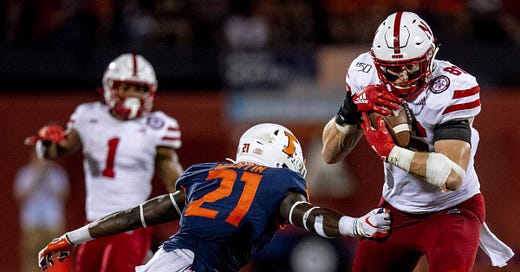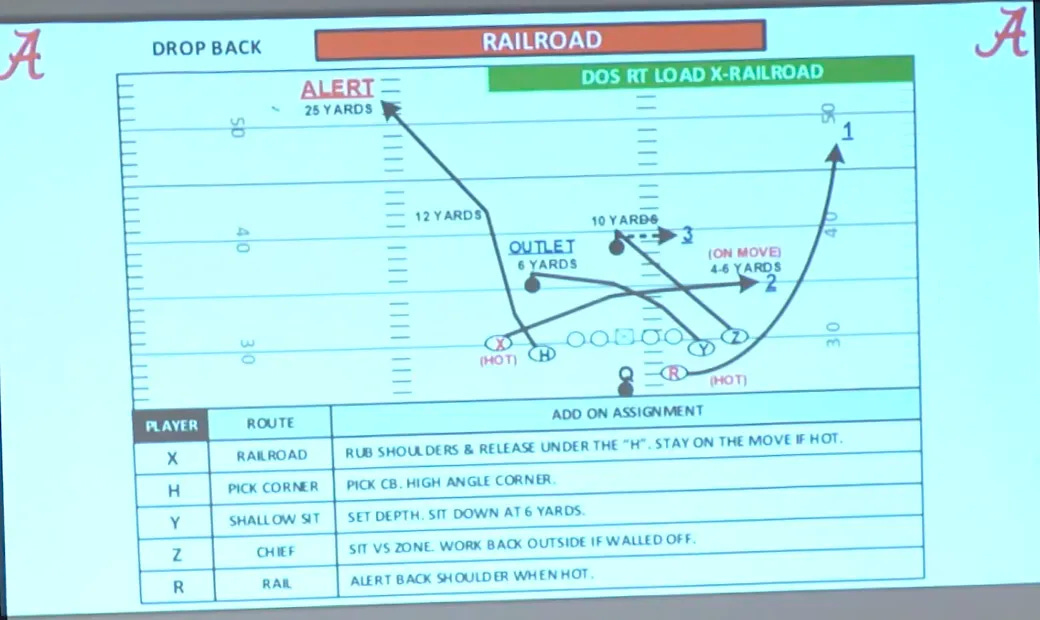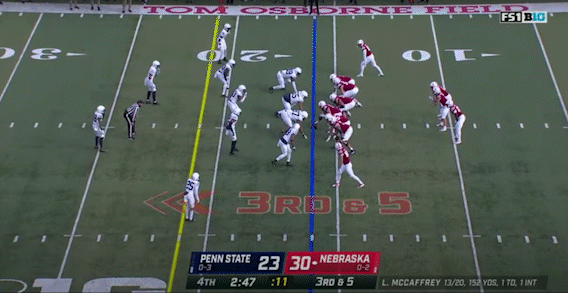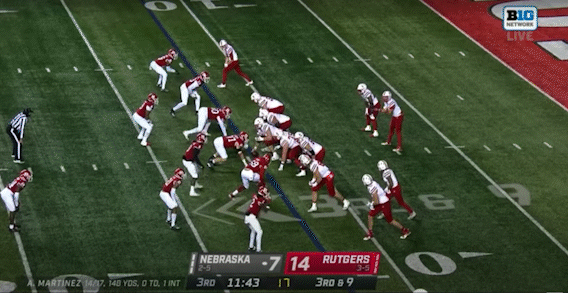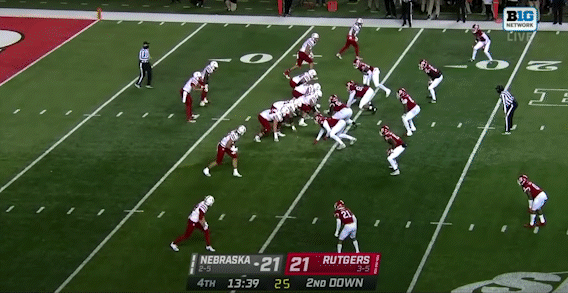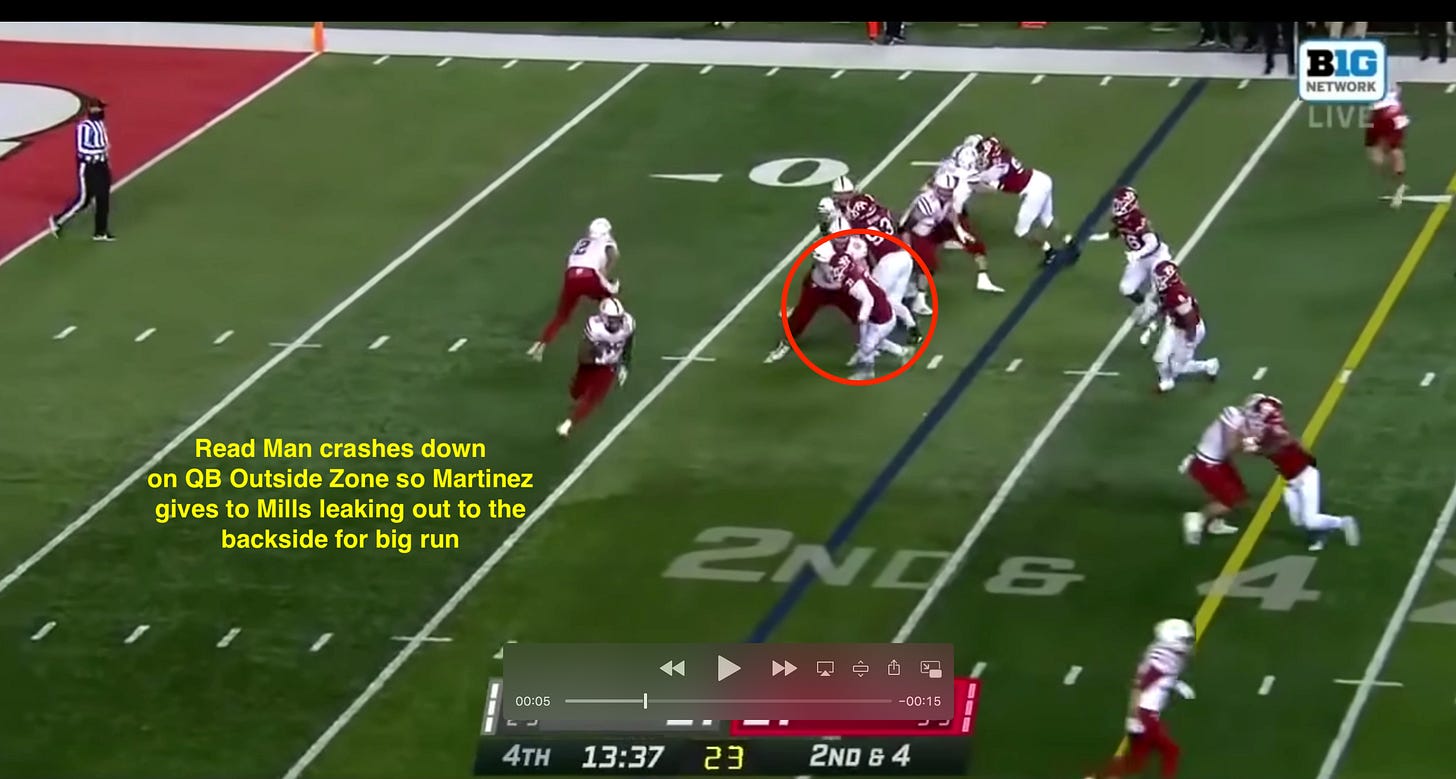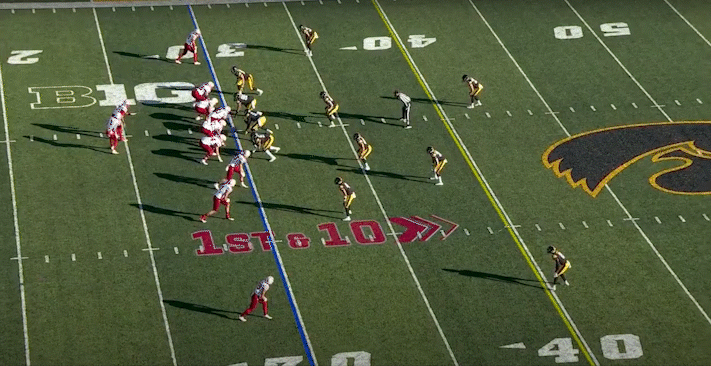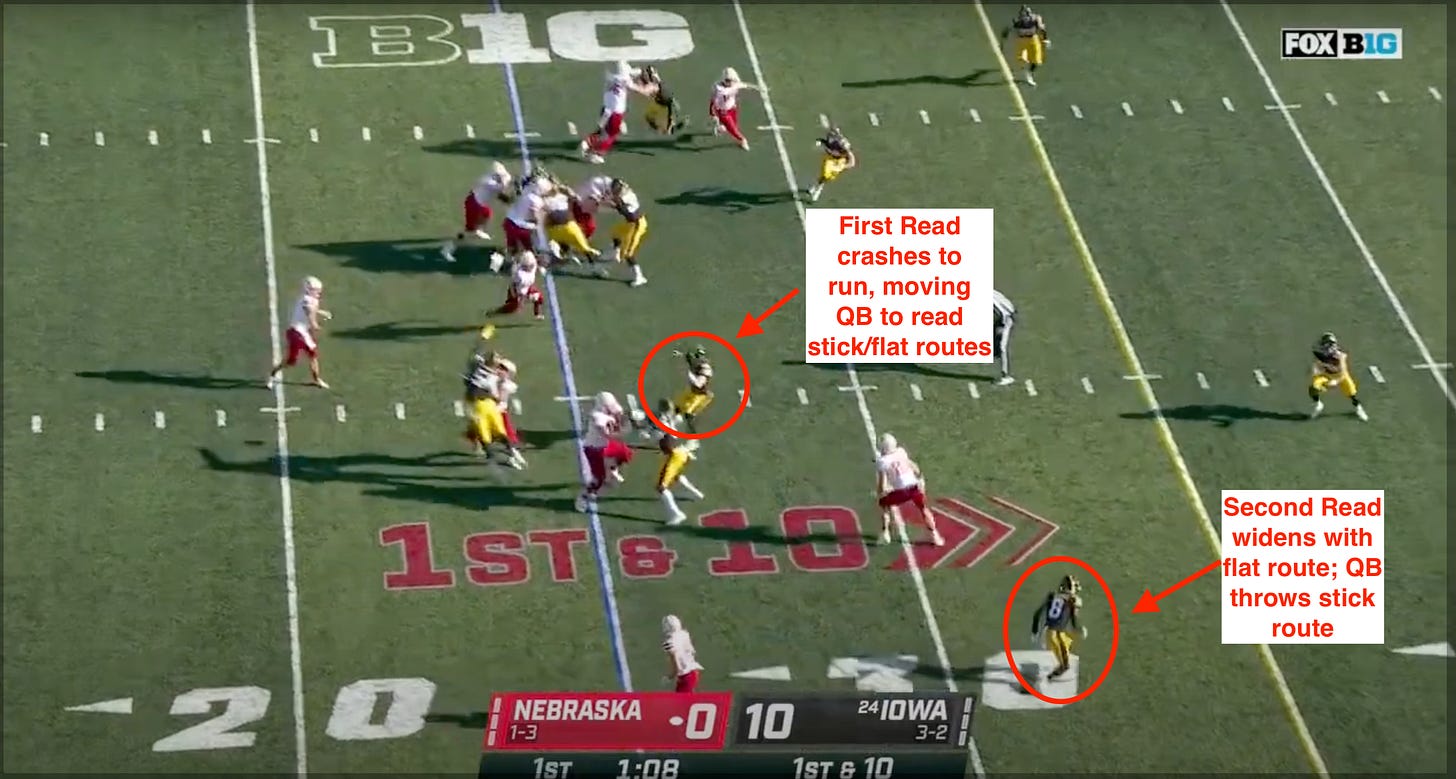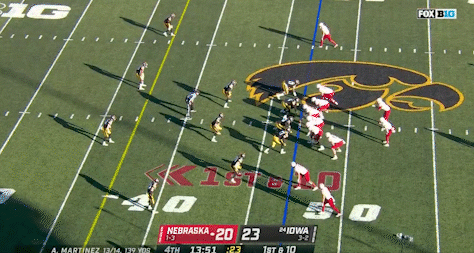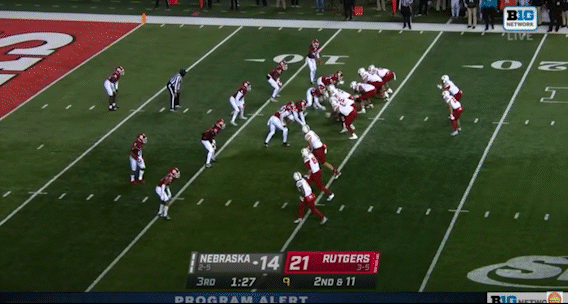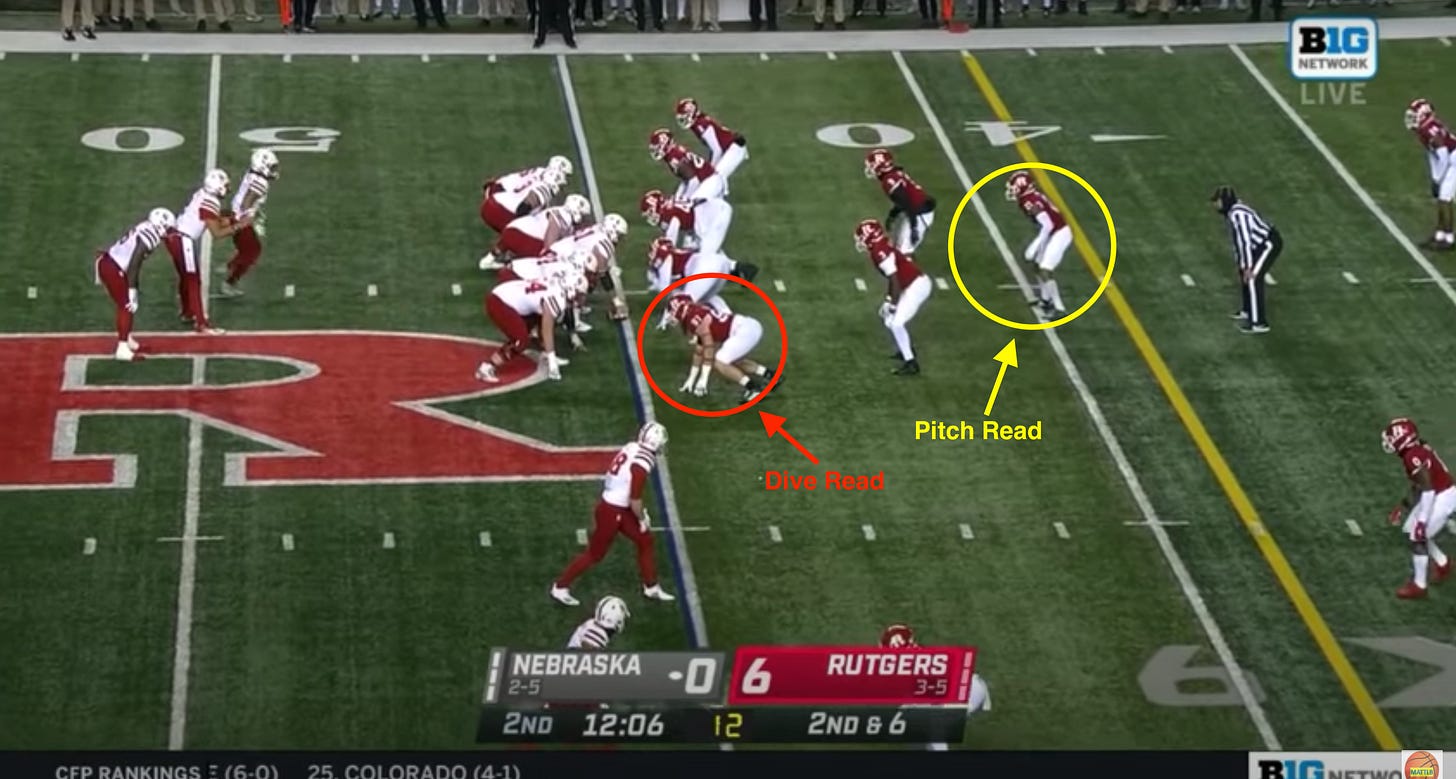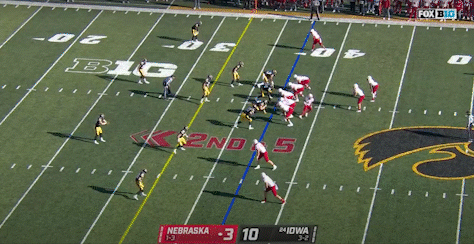5 Plays Nebraska Will Run Against Illinois
An in-depth look at some of the key concepts in the Huskers' offense ahead of Saturday's 2021 season opener
Having trouble viewing the full post in your e-mail? View it in the site archive!
We’re less than a week away from our BELOVED HUSKERS’ season opener against Illinois. Personally, I am VERY ready to leave the offseason that won’t stop punching Nebraska in the face behind and get to some actual football.
So let’s do it! Last week, I broke down some general trends of the Nebraska offense heading into the 2021 season. Today, I’m getting more specific, focusing on five key concepts within the Huskers’ offense. These aren’t the absolute most basic or most common building blocks of Nebraska’s offense — “Here’s inside zone!” isn’t particularly blowing anyone’s mind — but these ARE a handful of some slightly more interesting plays or concepts that the Huskers frequently ran last year and that opponents are likely preparing for as we enter 2021. As always, if you’re enjoying this newsletter, please subscribe to get all of the content delivered to your inbox, and please share with friends or other Husker fans!
Mesh Wheel
Mesh started as a concept used by some of the least talented teams in college football to level the playing field. LaVell Edwards is largely credited with inventing it at BYU, and Air Raid luminaries like Mike Leach perfected it in remote outposts like Lubbock, Texas, and Pullman, Washington.
It was last seen in college football being used by the Alabama “DEATH STAR” Crimson Tide to shatter every offensive record on the books.
That it’s become one of the most popular plays in football and used by some of its biggest names is not surprising; it’s a concept that has great answers for both man and zone coverage. At its most basic, it’s a pair of shallow crossing routes that “mesh” when they intersect in the middle of the field — creating traffic and pseudo-basketball picks called “rubs” that are difficult for man defenders to navigate and often spring one of the mesh receivers open. Against zone, receivers are taught to settle into the holes just past the mesh point that are created by the misdirection and widening linebackers. The other eligibles often run other in-breaking routes behind the mesh to cause more traffic over the middle of the field or deeper out-breaking routes or flat routes to take advantage of any defenses that are concentrating on the mesh action.
Nebraska ran the mesh concept several times a game last season in many variations, but it hammered a particularly virulent version, the “Mesh Wheel,” VERY often. With the linebacker focused on the mesh happening in front of them or caught in traffic from the crossing routes, and the secondary either locked onto the wide receivers in man or gaining depth for deeper zone coverages, having the running back run a “wheel” route instead of releasing to the flats can often spring a big play down the sideline.
Alabama has made Mesh Wheel famous in football circles the last few years, using wideouts like Jerry Jeudy, DeVonta Smith, and Henry Ruggs III to eviscerate man coverage on the drag routes or gum up the middle of the field to allow tailback Najee Harris to leak out and run past linebackers. Below is a video of then-offensive coordinator and now Texas head coach Steve Sarkisian explaining how he runs Mesh Wheel, which Alabama called “Railroad” (relevant portion is from 19:33 to 27:40):
Mesh was a concept Nebraska ran out of doubles and trips and ran interchangeably with receivers and tight ends. When it used the Mesh Wheel variation, it would often line Wan’Dale Robinson up as the running back to run the wheel route, as they did here against Penn State and Rutgers:
In the above play, Luke McCaffrey misreads the concept. His first read (Robinson on the wheel) and second read (Levi Falk on the crossing route working across the rubs) are both open, but he elects to throw to the over (what should be the last option on the play).
Here, Nebraska adds another layer to the concept by having Robinson motion into backfield from the slot — before he completely reverses field to run the wheel. The added misdirection (and that Wan’Dale is SICK AS HELL AND IMPOSSIBLE TO TACKLE) springs Robinson for a big gain.
Bash
On a typical read option play, the main blocking action of the play — whether it be inside or outside zone, power, counter, etc. — is designed for the running back. The quarterback has the option to pull the ball and run to the vacated space if the defender the offense is reading moves to take away that primary blocking action for the running back.
On a “Bash” play, it’s reversed: The primary blocking action of the play is designed for the quarterback to run behind, with the option to hand off to the running back leaking out the backside of the play should the read defender move to take away the primary action with the quarterback. It’s simple why it’s called “Bash” — “Back Away = “BAsh.”
Nebraska will do the traditional Bash action, with the running back simply taking the ball on the backside of a normally blocked play after an edge defender has crashed down. A lot of the big gains in the fourth quarters of the 2020 Rutgers game came on Bash concepts:
In this play, Nebraska is reading the end man on the line of scrimmage to the field. The play is blocked for quarterback Adrian Martinez to run outside zone to the boundary. Watch in the above .gif how the offensive linemen move.
But the read man doesn’t stay home — he aggressively crashes down with the outside zone blocking, leaving no one to stop Dedrick Mills leaking out the backside, even if the play isn’t blocked for him. Martinez lets him take the ball.
And with some good downfield blocking from the receivers, he’s sprung for a big gain.
The Huskers will also sometimes take these plays a step further, running specific blocking concepts for the back leaking out on Bash concepts. Here they again block for the quarterback outside zone to the boundary while reading the end player to the field, but they add to it by having the backside tackle arc block to the field should the read player dictate the ball go to the running back (which happens).
Here are two examples from the 2018 season from Twitter account (and great follow if you’re interested in scheme or cool plays) @CoachDanCasey:

Stick RPO
“Stick” tags have found their way onto a lot of Nebraska’s inside and outside zone plays since Matt Lubick took over as offensive coordinator last season. Here’s a more in-depth explainer of the Stick concept, but at its simplest, it’s a route combination that tests the defense vertically with a short curl route and tests it horizontally with a flat route. When added to a running concept, it creates one of the “modern triple option” plays I discussed last week.
Here’s an example in last season’s Iowa game:
Nebraska reads the Will linebacker and boundary corner. Should the Will stay wide with the short curl, or “stick,” route, quarterback Luke McCaffrey will hand to the running back on the outside zone play. Notice how the offensive line is blocking for outside zone. Should the Will crash down on the run, McCaffrey will pull the ball and look to the boundary corner for which of the two routes he should throw.
The linebacker crashes down on the run, so McCaffrey pulls the ball and gets his eyes to the boundary corner/second read, who has widened with the flat route run by Kade Warner. McCaffrey then rightly throws to the stick route for a nice gain and nearly a first down.
Nebraska dressed this particular RPO up with a fly motion by Warner that turned into the flat route. Far more often, NU would run this concept with two tight ends to the same side to run the routes. Overall, it’s a great concept to run against defenses that are getting overaggressive to run actions or packing a lot of people in the middle of the field, and a safe, easy throw that keeps the offense on schedule.
Swing/QB Run RPOs
“Swing passes” has become a meme for the fanbase, but attaching swing pass tags to your running concepts is a great way to put a defender in conflict and get people out of the box. Here is one from the Iowa game attached to a quarterback draw.
Martinez is reading numbers to each side of the formation to decide where to go with the ball, but it essentially comes down to one player: the strongside Mike linebacker, circled below. Should the Mike shade inside or stay home to defend the run concept, Martinez throws the swing route with a three-blockers-on-two-defenders number advantage. If the Mike runs to the swing route, Martinez keeps it himself on a draw into a five-man box:
The Mike immediately runs to the swing route, making this one an easy decision to keep. Martinez makes a guy miss to rip off a big gain (that gets called back by a penalty):
Draw isn’t the only QB run concept they’ll tag a swing route onto. They had a lot of success running a traditional power play with the swing route attached, examples below.
They’re again reading the weakside Mike, who stays home on both plays, giving Martinez throw reads. In the first example, the weakside defensive end makes an excellent play to sniff out the swing route and wreck the play, so Martinez improvises and keeps (and fumbles). In the second, Austin Allen whiffs on a perimeter block to get the running back blown up in the backfield.
Below is video from @CoachDanCasey again (you really should follow him) showing them running it with a QB Dart concept — a tackle pulling around to lead block — with a swing tagged on in Scott Frost’s first season as coach.

So next time you complain about a swing pass, know that it’s probably just what the defense was dictating.
Triple Option
I’m not gonna spend too much time here: You’d have to have lived under a rock to be a Nebraska fan not familiar with the triple option, and last week’s post went into ways that the current Huskers are bringing triple option concepts to the modern age.
I just wanted to reiterate that it’s a concept that is key to NU’s offensive attack. Here’s a more traditional triple option look that sprung a big play against Rutgers:
Look in these screenshots at how the reads develop. The Dive Read stays wide while the Pitch Read takes the bait and and runs to the quarterback. Nobody takes Mills on the dive.

Almost nothing in football is more satisfying to me than when a triple option play busts open like this. If this play looks familiar it was a longtime Chip Kelly Oregon Ducks staple …
I also wanted to point out this nice reverse off this look the staff pulled out for a big gain against Iowa.
Take that, Hawkeyes.
GBR
PROGRAMMING NOTES
I’ll have a preview of the Illinois game for everyone later in the week. THIS IS THE ONLY GAME PREVIEW THAT WILL BE POSTED ON THE SITE BEFORE THE GAME. All future game previews will only be sent out to e-mail subscribers before the game and posted on the site afterward. Smash the subscribe button below to make sure the previews — and all of Black 41 Flash Reverse’s content — are sent to your inbox. IT’S FREE. And share with any fellow Husker maniacs you might know.


